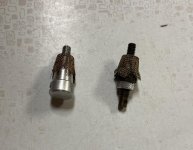I've shot countless 1000's of the 38spl's in my 357mags since the 80's. It was a common practice back then simply because the 38spl cases were soooooo common. It was mothing to buy 1000 1x fired 38spl cases for $10.
I cast my own bullets, my 1st mold was a 6-cavity h&g #50 148gr button nosed wc mold. Back then I lubed those cast bullets with the old nra 50/50 lube. I either used bullseye or www452/trap 100 for powders.
Those reloads were absolutely filthy to shoot, tons of smoke and black suit on the firearms. There was no shortage of massive carbon rings to clean out of the cylinders after a +/- 400 round range session.
I wanted to learn how to shoot a revolver accurately and bought a s&w 586 and shot +/- 1000 reloads with those h&g #50's in the 38spl brass every week.
I quickly learned I didn't need to lube that wc in all 3 lube grooves. This actually made the reloads more accurate and cut down on the smoke/crud/carbon ring.
I also quickly learned to use an old/worn copper bore brush chucked in a drill with copper choir boy wrapped around it to clean the cylinders. A little hoppe's #9 and +/- 30 seconds per cylinder hole and they were clean. It took longer to clean the cylinder face and top strap.
I also started moving the bullet out further in the 38spl cases (longer oal). This aided in slowing the carbon ring buildup by increasing the short start pressure/better initial burn. Along with increasing accuracy. I still load my 38spl reloads with the bullet long/out further to this day. A h&g #50 wc loaded long (right). A Mihec 640 series fn hp loaded long (bottom crimp groove/has upper and lower crimp grooves) left.
Cylinders have leade's in them, it's the sloped area in front of the cut area for the case ends. Putting the bullet out further into the leade aids in the bullets alignment along with giving the bullet resistance/seals faster increasing the short start pressure of the reload. This aids in a hotter/higher pressure burn/more complete burn of the powder and lube.
Those reloads loaded long in the 38spl cases (pictured above) shot in a 686 357mag @ 50ft. The 686 was bench rested and scoped, 6-shot groups @ 50ft.









